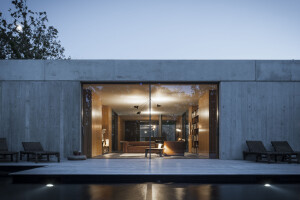The striking thing about the Swiss Alpine Club's (SAC) New Monte Rosa Hut is its autonomy in the heart of a sensitive landscape, an extreme climatic region far from comfortable civilised supply networks, in "splendid isolation" between seemingly untamed nature and highly urban culture. This applies to the production, the building site logistics, the autarkic infrastructure and the operation of the hut. The New Monte Rosa Hut is a case study project on the interface between the environment and the city. First in isolation does the immense sensitivity of the natural as well as the urban resources on which life depends become apparent.
This is not simply a matter of creating a sustainable building or an energy efficient mountain lodge, but more importantly the main issue is to create an awareness of these critical dependencies both in the sense of a respectful handling of natural resources in a landscape which is in fact finite, and in the transferability of the knowledge acquired on the site to the global city and its future development.
The New Monte Rosa Hut has a self-sufficiency level of greater than 90%. In order to achieve this goal saving- and generating strategies are used. Only the gas for cooking and food are brought in with a helicopter.
The ETH-Studio Monte Rosa
The project for the New Monte Rosa Hut originated in the studio of the same name at the Faculty of Architecture (DARCH) at the Swiss Federal Institute of Technology in Zurich (ETH Zurich), directed by the Chair of Architecture and Technology, Prof. Andrea Deplazes. Over the course of four semesters different groups of students worked in a multiphase process to develop the project and, as a result, dealt intensively with questions of sustainability. In total over 33 students have participated in the ETH-Studio Monte Rosa since its establishment in 2003. In this respect the ETH-Studio Monte Rosa constitutes a new, practice-oriented form of knowledge transfer and acquisition, which since its inception has expanded in the curriculum of the DARCH into "Architectural Design with Integrated Disciplines". Therefore the ETH-Studio Monte Rosa is a bit like an "architectural flight simulator", in that the next generation is already working on the solutions to the challenges of the future.
Something akin to a sphere The hut would be designed most energy-efficiently as a sphere or cylinder: this shape offers the lowest surface to volume ratio and least heat would escape. The present design comes close to this ideal scenario: the new hut is designed as a cut sphere into which a condensed package of rooms has been incorporated. It is visually evocative of crystallised quartz, an impression that is also emphasised by the shimmering outer aluminium skin. The particular requirements for the New Monte Rosa Hut helped to shape the design.
The architecture is also defined by the objectives – building with as few materials as possible, – saving as much energy as possible and – producing sufficient energy.
At the same time, the hut would have to blend into its Alpine surroundings as homogeneously as possible and serve as an architectural marker along the trail. In addition, it would have to meet the requirements of future visitors and satisfy topographical challenges. The project is based on a five-storey, segment-shaped wooden lathe building method. The computer-aided mechanical production process makes it possible to use traditional construction methods such as half-timber building with its geometrically complex wood junctions. The result is a wide range of possibilities for the use of timber. The concept of the highly insulated façade is the result of a mixture of energy saving and energy production. The facet-like, metallic skin is studded with photovoltaic panels that supply the building with the necessary operational energy. A spiral-shaped glass band that follows the sun and conducts passive energy into the dining room and peripherally ascending cascade staircase is wound around the whole building and presents the guest with an impressive landscape panorama.

























